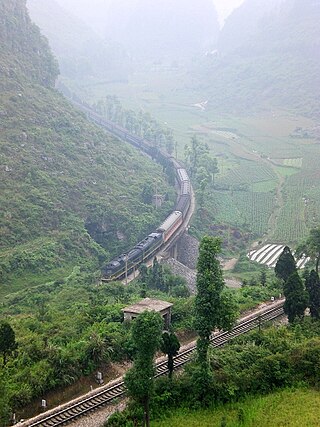
Guiyang is the capital of Guizhou province of the People's Republic of China. It is located in the center of the province, situated on the east of the Yunnan–Guizhou Plateau, and on the north bank of the Nanming River, a branch of the Wu River. The city has an elevation of about 1,100 meters (3,600 ft). It has an area of 8,034 square kilometers (3,102 sq mi). At the 2020 census, its population was 5,987,018, out of whom 4,506,134 lived in the six urban districts.
The Hmu language, also known as Qiandong Miao, Central Miao (中部苗语), East Hmongic, or Black Miao, is a dialect cluster of Hmongic languages of China. The best studied dialect is that of Yǎnghāo (养蒿) village, Taijiang County, Guizhou Province.

The Maritime Safety Administration of the People's Republic of China is a government agency of departmental grade (正司局级) under the Ministry of Transportation. The MSA administers all matters related to maritime and shipping safety, including the supervision of maritime traffic safety and security, prevention of pollution from ships, inspection of ships and offshore facilities, navigational safety measures, administrative management of port operations, and law enforcement on matters of maritime safety law. It was also responsible for marine accident investigation. It is headquartered in Dongcheng District, Beijing.

Haneda Airport, sometimes referred to as Tokyo-Haneda, is the busier of the two international airports serving the Greater Tokyo Area, the other one being Narita International Airport (NRT). It serves as the primary domestic base of Japan's two largest airlines, Japan Airlines and All Nippon Airways, as well as RegionalPlus Wings Corp., Skymark Airlines, and StarFlyer. It is located in Ōta, Tokyo, 15 kilometers (9.3 mi) south of Tokyo Station. The facility covers 1,522 hectares of land.

The Lanzhou–Haikou Expressway, designated as G75 and commonly referred to as the Lanhai Expressway, is an expressway in China that connects the cities of Lanzhou, Gansu, and Haikou, Hainan. When fully complete, it will be 2,570 km (1,600 mi) in length. It is one of the most important routes between Northwest China and the Southwest, and considered one of the developmental axes of Development of Western China.
Guiyang–Guangzhou high-speed railway, also known as the Guiguang HSR, is a high-speed railway line in southern China between Guiyang in Guizhou Province and Guangzhou in Guangdong Province. The railway is dedicated to high speed passenger rail service. The line is 856 km (532 mi) in length and can carry trains at speeds of up to 250 km/h (155 mph). The line was built from 2008 to 2014 and opened on December 26, 2014.

The Guizhou–Guangxi railway or Qian'gui railway, also written as the Kweichow–Kwangsi railway is a single-track electrified railroad in Southwest China between Guiyang in Guizhou Province and Liuzhou in Guangxi Zhuang Autonomous Region. The shorthand name for the line, Qiangui, is derived from the shorthand names of Guizhou and Guangxi.
The Guiyang–Kaiyang intercity railway is a higher-speed railway within Guizhou province, connecting the provincial capital of Guiyang to Kaiyang. It starts at Guiyang North station, travelling 62 km (39 mi) north-east to Kaiyang station.

Yunnan Ying'an Airlines, branded as Ying'an Airlines, was a Chinese regional airline based at Guiyang Longdongbao International Airport in Guizhou. It operated flights throughout Yunnan Province as well as in Guizhou Province using a single Xian MA60 aircraft.

China Railways 25G rolling stock, or China Railways 25 improved rolling stock is a series of passenger carriages built in China. The carriages run services in mainland China, and on the Trans-Siberian Railway for international services to Moscow. They are also exported to Mombasa–Nairobi Standard Gauge Railway, Addis Ababa–Djibouti Railway, Guinea railways, Uganda Standard Gauge railways and Boten-Vientiane railway.

On 23 January 2020, the central government of China imposed a lockdown in Wuhan and other cities in Hubei in an effort to quarantine the center of an outbreak of COVID-19; this action was commonly referred to as the Wuhan lockdown. The World Health Organization (WHO), although stating that it was beyond its own guidelines, commended the move, calling it "unprecedented in public health history".

The COVID-19 pandemic in mainland China is part of the worldwide pandemic of coronavirus disease 2019 (COVID-19) caused by severe acute respiratory syndrome coronavirus 2 (SARS-CoV-2). China was where the first COVID outbreak occurred, the first where authorities imposed drastic measures in response, and was one of the first countries to bring the outbreak under control, at least temporarily.

The COVID-19 pandemic in Shanghai is a part of the worldwide pandemic of coronavirus disease 2019 (COVID-19) caused by severe acute respiratory syndrome coronavirus 2 (SARS-CoV-2). The disease was first confirmed in Shanghai on 20 January 2020. As of 14 October 2022, 65,641 confirmed cases cumulatively occurred in the city, of which 3,045 cases were imported from abroad. Of the 96 active hospitalized cases ending at midnight, 94 were in stable condition and 1 was in critical condition; 61,600 had cumulatively recovered and been discharged, and 595 died.

The COVID-19 pandemic had a large impact on public transport. Many countries advised that public transport should only be used when essential; passenger numbers fell drastically, and services were reduced. Provision of a reasonable service for the much smaller number of fare-paying passengers incurred large financial losses.

On 7 July 2020, a local bus in Anshun, Guizhou, in southwest China, made a sharp turn and crashed into the Hongshan Reservoir in Xixiu District. At least 21 people died and 16 others were injured. Among the passengers on the bus were candidates for the Gaokao examination.
Health Code is a type of application used during COVID-19 in mainland China. It was used as an e-passport that reports if the user has been in an area with current cases of infection. An applicant provides information such as travel history, residence, and medical records. The application will then generate a QR code that identifies the individual's risk level as red, yellow, or green. As of April 2020, over 200 cities and 20 provinces employed health code supported by Alipay. There are a wide range of health codes run by different localities.While many assumed these codes would be phased out after the pandemic, research indicates their continued use and integration beyond the health crisis.

On 1 May 2008, at approximately 09:02 HKT, a tour bus flipped onto its side on Hiram's Highway in Sai Kung District, New Territories. The crash killed 19 people and injured 43.

Zero-COVID, also known as COVID-Zero and "Find, Test, Trace, Isolate, and Support" (FTTIS), was a public health policy implemented by some countries, especially China, during the COVID-19 pandemic. In contrast to the "living with COVID-19" strategy, the zero-COVID strategy was purportedly one "of control and maximum suppression". Public health measures used to implement the strategy included as contact tracing, mass testing, border quarantine, lockdowns, and mitigation software in order to stop community transmission of COVID-19 as soon as it was detected. The goal of the strategy was to get the area back to zero new infections and resume normal economic and social activities.
Events in the year 2022 in China.
Gao Weidong is a Chinese business executive and politician who served as chairman of the Board of Kweichow Moutai from 2020 to 2021. As of May 2022 he was under investigation by China's top anti-corruption agency. He is a delegate to the 13th National People's Congress.















